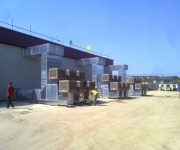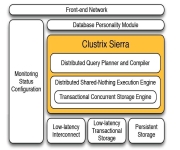Author Archive

I recently came across a nice data center cooling design by Alan Beresford of EcoCooling Ltd. In this approach, EcoCooling replaces the CRAC units with a combined air mover, damper assembly, and evaporative cooler. I’ve been interested by evaporative coolers and their application to data center cooling for years and they are becoming more common…
Wide area network costs and bandwidth shortage are the most common reasons why many enterprise applications run in a single data center. Single data center failure modes are common. There are many external threats to single data center deployments including utility power loss, tornado strikes, facility fire, network connectivity loss, earthquake, break in, and many…

Earlier this week Clustrix announced a MySQL compatible, scalable database appliance that caught my interest. Key features supported by Clustrix: · MySQL protocol emulation (MySQL protocol supported so MySQL apps written to the MySQL client libraries just work) · Hardware appliance delivery package in a 1U package including both NVRAM and disk · Infiniband interconnect…
Rich Miller of Datacenter Knowledge covered this last week and it caught my interest. I’m super interested in modular data centers (Architecture for Modular Datacenters) and highly efficient infrastructure (Data Center Efficiency Best Practices) so the Yahoo! Computing Coop caught my interest. As much as I like the cost, strength, and availability of ISO standard…
Facebook released Flashcache yesterday: Releasing Flashcache. The authors of Flashcache, Paul Saab and Mohan Srinivasan, describe it as “a simple write back persistent block cache designed to accelerate reads and writes from slower rotational media by caching data in SSD’s.” There are commercial variants of flash-based write caches available as well. For example, LSI has…

There have been times in past years when it really looked like we our industry was on track to supporting only a single relevant web browser. Clearly that’s not the case today. In a discussion with a co-working today on the importance of “other” browsers, I wanted to put some data on the table so…
We live on a boat which has lots of upside but broadband connectivity isn’t one of them. As it turns out, our marina has WiFi but it is sufficiently unreliable that we needed another solution. I wish there was a Starbucks hotspot across the street – actually there is one within a block but we…
Standards and benchmarks have driven considerable innovation. The most effective metrics are performance-based. Rather than state how to solve the problem, they say what needs to be achieved and leave the innovation open. I’m an ex-auto mechanic and was working as a wrench in a Chevrolet dealership in the early 80. I hated the emission…
High scale network research is hard. Running a workload over a couple of hundred servers says little of how it will run over thousands or tens of thousands servers. But, having 10’s of thousands of nodes dedicated to a test cluster is unaffordable. For systems research the answer is easy: use Amazon EC2. It’s an…
Mike Stonebraker published an excellent blog posting yesterday at the CACM site: Errors in Database Systems, Eventual Consistency, and the CAP Theorem. In this article, Mike challenges the application of Eric Brewer’s CAP Theorem by the NoSQL database community. Many of the high-scale NoSQL system implementers have argued that the CAP theorem forces them to…
Every so often, I come across a paper that just nails it and this one is pretty good.. Using a market Economy to Provision Resources across a Planet-wide Clusters doesn’t fully investigate the space but it’s great to progress on this important area and the paper is a strong step in the right direction. I…
I love eventual consistency but there are some applications that are much easier to implement with strong consistency. Many like eventual consistency because it allows us to scale-out nearly without bound but it does come with a cost in programming model complexity. For example, assume your program needs to assign work order numbers uniquely and…
MySpace makes the odd technology choice that I don’t fully understand. And, from a distance, there are times when I think I see opportunity to drop costs substantially. But, let’s ignore that, and tip our hat to the MySpace for incredibly scale they are driving. It’s a great social networking site and you just can’t…
Last week, I posted Scaling Second Life. Royans sent me a great set of scaling stories: Scaling Web Architectures and Vijay Rao of AMD pointed out How FarmVille Scales to Harvest 75 Million Players a Month. I find the Farmville example particularly interesting in that it’s “only” a casual game. Having spent most of my…
As many of you know I collect high-scale scaling war stories. I’ve appended many of them below. Last week Ars Technica published a detailed article on Scaling Second Life: What Second Life can Teach your Datacenter About Scaling Web Apps. This article by Ian Wilkes who worked at Second Life from 2001 to 2009 where…
Cloud computing is an opportunity to substantially improve the economics of enterprise IT. We really can do more with less. I firmly believe that enterprise IT is a competitive weapon and, in all industries, the leaders are going to be those that invest deeply in information processing. The best companies in each market segment are…

I recently came across a nice data center cooling design by Alan Beresford of EcoCooling Ltd. In this approach, EcoCooling replaces the CRAC units with a combined air mover, damper assembly, and evaporative cooler. I’ve been interested by evaporative coolers and their application to data center cooling for years and they are becoming more common…
Wide area network costs and bandwidth shortage are the most common reasons why many enterprise applications run in a single data center. Single data center failure modes are common. There are many external threats to single data center deployments including utility power loss, tornado strikes, facility fire, network connectivity loss, earthquake, break in, and many…

Earlier this week Clustrix announced a MySQL compatible, scalable database appliance that caught my interest. Key features supported by Clustrix: · MySQL protocol emulation (MySQL protocol supported so MySQL apps written to the MySQL client libraries just work) · Hardware appliance delivery package in a 1U package including both NVRAM and disk · Infiniband interconnect…
Rich Miller of Datacenter Knowledge covered this last week and it caught my interest. I’m super interested in modular data centers (Architecture for Modular Datacenters) and highly efficient infrastructure (Data Center Efficiency Best Practices) so the Yahoo! Computing Coop caught my interest. As much as I like the cost, strength, and availability of ISO standard…
Facebook released Flashcache yesterday: Releasing Flashcache. The authors of Flashcache, Paul Saab and Mohan Srinivasan, describe it as “a simple write back persistent block cache designed to accelerate reads and writes from slower rotational media by caching data in SSD’s.” There are commercial variants of flash-based write caches available as well. For example, LSI has…

There have been times in past years when it really looked like we our industry was on track to supporting only a single relevant web browser. Clearly that’s not the case today. In a discussion with a co-working today on the importance of “other” browsers, I wanted to put some data on the table so…
We live on a boat which has lots of upside but broadband connectivity isn’t one of them. As it turns out, our marina has WiFi but it is sufficiently unreliable that we needed another solution. I wish there was a Starbucks hotspot across the street – actually there is one within a block but we…
Standards and benchmarks have driven considerable innovation. The most effective metrics are performance-based. Rather than state how to solve the problem, they say what needs to be achieved and leave the innovation open. I’m an ex-auto mechanic and was working as a wrench in a Chevrolet dealership in the early 80. I hated the emission…
High scale network research is hard. Running a workload over a couple of hundred servers says little of how it will run over thousands or tens of thousands servers. But, having 10’s of thousands of nodes dedicated to a test cluster is unaffordable. For systems research the answer is easy: use Amazon EC2. It’s an…
Mike Stonebraker published an excellent blog posting yesterday at the CACM site: Errors in Database Systems, Eventual Consistency, and the CAP Theorem. In this article, Mike challenges the application of Eric Brewer’s CAP Theorem by the NoSQL database community. Many of the high-scale NoSQL system implementers have argued that the CAP theorem forces them to…
Every so often, I come across a paper that just nails it and this one is pretty good.. Using a market Economy to Provision Resources across a Planet-wide Clusters doesn’t fully investigate the space but it’s great to progress on this important area and the paper is a strong step in the right direction. I…
I love eventual consistency but there are some applications that are much easier to implement with strong consistency. Many like eventual consistency because it allows us to scale-out nearly without bound but it does come with a cost in programming model complexity. For example, assume your program needs to assign work order numbers uniquely and…
MySpace makes the odd technology choice that I don’t fully understand. And, from a distance, there are times when I think I see opportunity to drop costs substantially. But, let’s ignore that, and tip our hat to the MySpace for incredibly scale they are driving. It’s a great social networking site and you just can’t…
Last week, I posted Scaling Second Life. Royans sent me a great set of scaling stories: Scaling Web Architectures and Vijay Rao of AMD pointed out How FarmVille Scales to Harvest 75 Million Players a Month. I find the Farmville example particularly interesting in that it’s “only” a casual game. Having spent most of my…
As many of you know I collect high-scale scaling war stories. I’ve appended many of them below. Last week Ars Technica published a detailed article on Scaling Second Life: What Second Life can Teach your Datacenter About Scaling Web Apps. This article by Ian Wilkes who worked at Second Life from 2001 to 2009 where…
Cloud computing is an opportunity to substantially improve the economics of enterprise IT. We really can do more with less. I firmly believe that enterprise IT is a competitive weapon and, in all industries, the leaders are going to be those that invest deeply in information processing. The best companies in each market segment are…